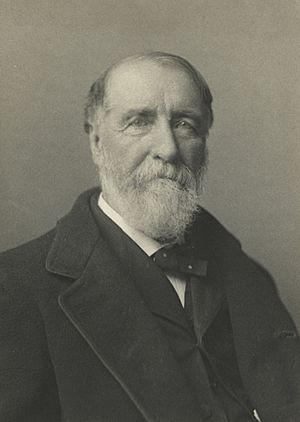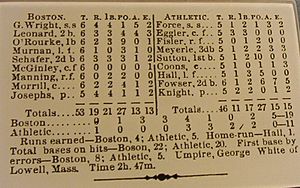Henry Chadwick (writer) facts for kids
Quick facts for kids
Henry Chadwick
|
|
|---|---|
 |
|
| Born | October 5, 1824 Exeter, Devon, England, United Kingdom |
| Died | April 20, 1908 (aged 83) Brooklyn, New York, United States |
| Resting place | Green-Wood Cemetery |
| Occupation | Sportswriter |
| Nationality | English, American |
| Period | circa 1850–1908 |
| Subject |
|
| Notable works |
|
| Henry Chadwick | |
|---|---|
| Induction | 1938 |
| Election Method | Centennial Committee |
Henry Chadwick (born October 5, 1824 – died April 20, 1908) was an English-American sportswriter. He was also a baseball statistician and historian. Many people call him the "Father of Baseball." This is because he reported on the game early on and helped it grow.
Chadwick edited the first baseball guide sold to the public. He also created the baseball box score. He invented the letter "K" to show a strikeout. He is also known for creating statistics like batting average and earned run average (ERA). After he died, he was added to the National Baseball Hall of Fame in 1938.
Contents
Henry Chadwick's Early Life
Henry Chadwick was born in Exeter, England. When he was 12, his family moved to Brooklyn, New York. He learned a lot about moral ideas and science. He did not focus on owning many things.
Chadwick started writing music. He also taught people how to play piano and guitar.
In 1848, Chadwick married Jane Botts. They had three children: Richard, Susan, and Rose.
Chadwick loved playing cricket and other ball games like rounders. He began writing about cricket for local newspapers. In 1856, he saw his first organized baseball game. He was reporting on cricket for The New York Times.
In 1857, Chadwick started writing mainly about baseball. He joined the New York Clipper. He also wrote for other New York papers, like the Sunday Mercury.
How Chadwick Helped Baseball Grow
Making Baseball Popular
Henry Chadwick played a big role in making baseball popular. This happened around the start of the 1900s. He was good with numbers and a professional writer. He helped shape how people saw the game. He also created the way we record player and team achievements. This was the start of baseball statistics.
He also served on committees that made baseball rules. This means he helped change the game itself. People sometimes call him "the father of baseball." This is because he helped the sport become well-known in its early days.
Early baseball had a rule called the "bound rule." This rule meant a fielder could catch a batted ball after one bounce. It would still count as an out. Chadwick thought this rule was wrong. He said fielders should have to catch the ball in the air for it to be an out. In 1864, they removed the bound rule for balls hit into fair play.
Chadwick edited The Beadle Dime Base-Ball Player. This was the first baseball guide sold to the public every year. He also edited the Spalding and Reach guides for many years. Through these guides, he helped make the game popular. He also helped create sports journalism. In his 1861 Beadle guide, he listed totals for games played, outs, runs, home runs, and strikeouts. This was for hitters on important teams. It was the first database of its kind. He wanted to show with numbers which players helped a team win.
In 1867, he traveled with the National Base Ball Club. They went on their first national tour. Chadwick was their official scorer. The next year, he wrote The Game of Base Ball. This was the first hardcover baseball book. In 1874, he helped set up a tour of England. This tour included games of both baseball and cricket. As a journalist, he spoke out against drinking and gambling. He felt these things hurt the game.
Creating Box Scores and Statistics
Chadwick is known for creating the baseball box score. He got the idea from cricket scorecards. The first box score appeared in the Clipper in 1859. It was a grid with nine rows for players and nine columns for innings. The original box scores also used "K" for a strikeout. "K" is the last letter of "struck" in "struck out." Chadwick also gave numbers to each defensive position. This system is still used in baseball scorekeeping today.
Newspapers used to just count runs scored. But Chadwick's 1859 box score looked much like the ones we see today. The box score became very popular in 1925. That's when Baseball Magazine reprinted Chadwick's 1859 Clipper article.
Chadwick also created baseball statistics like batting average and earned run average (ERA). He believed batting average best showed how good a batter was at hitting.
He first counted walks as errors for the pitcher. Walks did not exist in cricket. When he learned about them in baseball, he felt they did not show offensive skill. Later, he removed walks from baseball statistics completely.
ERA was created to show the difference between runs caused by hitting and runs caused by fielding mistakes. He also thought that a player's ability to cover ground in the field was more important than avoiding errors.
Henry Chadwick's Legacy
Henry Chadwick was elected to the Baseball Hall of Fame in 1938. This was because of his many contributions to the game. He was inducted at the same time as Alexander Cartwright.
In 2009, the Society for American Baseball Research (SABR) created the Henry Chadwick Award. This award honors great baseball researchers. Bill James and John Thorn are some people who have received this award.
In 2004, a collection of old baseball items was sold. It included a letter written by Chadwick about how baseball started. It sold for $310,500.
Chadwick was also added to the Suffolk Sports Hall of Fame in 2020.


